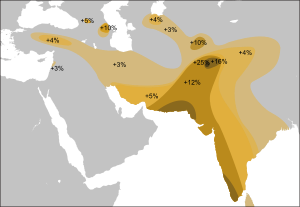- Haplogrupo L ADN-Y
-
En genética humana, el Haplogrupo L (M20) es un haplogrupo del ADN del cromosoma Y humano , derivado del haplogrupo LT y es característico del Subcontinente indio. Está asociado a antiguos pobladores de la India y tiene una antigüedad aproximada de 30.000 años.
Contenido
Distribución
Es característico de la región del Sur de Asia. Hay pequeñas frecuencias en poblaciones del Asia Central, Medio oriente y costas del Mediterráneo.
La mayor frecuencia está en los hindúes del sur, siendo allí cercana al 50%(e.g. Wells et al. 2001), por lo que se relaciona con los drávidas o hablantes de lenguas dravídicas. Importante frecuencia y diversidad se encuentra en Pakistán: en Baluchistán (costa oeste) con un 28% y en los kalash (noroeste) con 23%. En el resto del subcontinente, rara vez alcanza el 25%.
En otros lugares encontramos 5% en druzos,[1] 4% en Irán (Regueiro et al. 2006), 3% en Turquía (Cinnioğlu et al. 2004), 1,6% en armenios[2] y menores frecuencias en el Mediterráneo.
Sengupta et al. (2006) descubren recientemente tres subramas de L: L1 (M76), L2 (M317), y L3 (M357), las cuales están presentes en Irán and Pakistán, pero solo L1 es común en la India.
Subclados
Según the 2010 ISOGG tree tenemos los siguientes subgrupos:
- Haplogrupo L (M11, M20, M22, M61, M185, M295) Común en India y Pakistán
- L* En Irlanda y Europa Oriental.[3]
- L1 (M27, M76) Característico de los drávidas, castas de la India y Ceilán, importante en Maharashtra y presencia moderada en indo-iraníes. También en Pakistán, Sur de Irán, Baluchisán y Arabia
- L2 (M317) Baja frecuencia en Asia Central, Medio oriente, Sur de Europa y menor aún en Asia Oriental
- L2*
- L2a (M274)
- L2b (M349): Principalmente en Europa.
- L3 (M357) Frecuente entre los burushos, pashtunes, chechenos y kalashas, con moderada distribución en Pakistán y en particular en el valle del Indo. También al norte de Irán, en India, Georgia y Arabia.
- L3*
- L3a (PK3) común en los kalashas
Adán cromosómico-Y A BT B CT DE CF D E C F G H IJK IJ K I J LT MNOPS L T M NO P S N O Q R R1 R2 R1a R1b Referencias
- ↑ 12/222 Shlush et al. 2008
- ↑ Michael E. Weale, Levon Yepiskoposyan, Rolf F. Jager, Nelli Hovhannisyan, Armine Khudoyan, Oliver Burbage-Hall, Neil Bradman, Mark G. Thomas, "Armenian Y chromosome haplotypes reveal strong regional structure within a single ethno-national group," Human Genetics (2001) 109 : 659–674.
- ↑ FTDNA lab results, May 2011
- R. Spencer Wells et al: "The Eurasian Heartland: A continental perspective on Y-chromosome diversity." Proceedings of the National Academy of Sciences of the United States of America v.98(18); Aug 28, 2001
- M. Regueiro et al.: "Iran: Tricontinental Nexus for Y-Chromosome Driven Migration," Human Heredity, 2006, vol. 61, pp. 132–43.
- C. Cinnioğlu et al., "Excavating Y-chromosome haplotype strata in Anatolia," Hum Genet (2004) 114 : 127–148, http://evolutsioon.ut.ee/publications/Cinnioglu2004.pdf
- S. Sengupta et al.: Polarity and Temporality of High-Resolution Y-Chromosome Distributions in India Identify Both Indigenous and Exogenous Expansions and Reveal Minor Genetic Influence of Central Asian Pastoralists. American Journal of Human Genetics, 2006, p. 202-221
Enlaces externos
- Haplogrupo L (M11, M20, M22, M61, M185, M295) Común en India y Pakistán
Wikimedia foundation. 2010.

